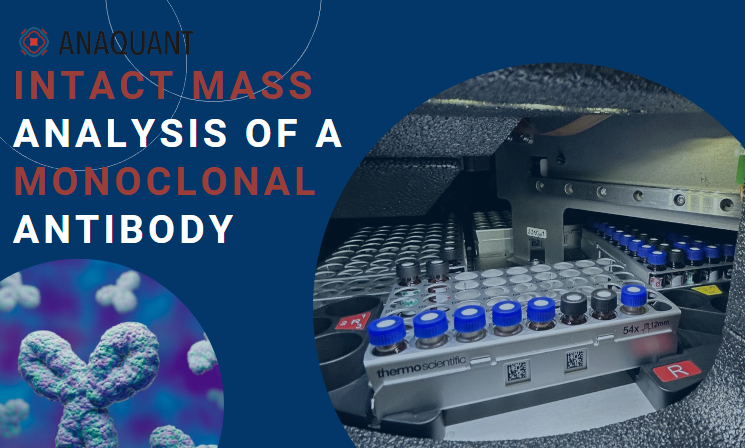
Introduction
LC-MS is widely used in the Biopharmaceutical industry for the characterization of therapeutic proteins. Key advantages of this method include protein identity confirmation by molecular weight analysis as well as glycoforms profiling. Therapeutic proteins are thus controlled in terms of their correct sequence and post-translational modifications.
Monoclonal antibodies constitute one of the largest and most rapidly expanding classes of therapeutic proteins.
In this application note, we report the characterization of a Nist mAb reference material (Nist 8671) by Intact Mass Analysis on the Orbitrap Exploris™ 240 MS coupled to a Vanquish NEO Liquid Chromatography system. This characterization includes intact protein analysis and glycosylation profiling.
Material and Methods
Sample preparation:
Buffer exchange was performed on 75 µg of Nist mAb with ammonium bicarbonate using Amicon 30KDa. The desalted sample was then aliquoted for the different analyses.
- Intact Protein Analysis
An aliquot of the desalted sample was diluted in ammonium bicarbonate prior to injection into the LC-MS system.
- Glycosylation Profile Analysis
An aliquot of the desalted sample was deglycosylated with PNGaseF (GibcoTM) at 50°C for 1 hour, prior to dilution in ammonium bicarbonate and injection into the LC-MS system.
LC-MS analysis
LC-MS analyses were conducted on a Vanquish NEO liquid chromatography system coupled to an Orbitrap Exploris™ 240 MS (both instruments from Thermo Fisher Scientific). 500 ng of mAb from each condition were injected on a Bioresolve RP mAb Polyphenyl, 450A 2.7µm 1.0x100mm column (Waters).
Results
Chromatographic profiles, raw MS spectra and deconvoluted MS spectra obtained for the intact Nist mAb and the deglycosylated Nist mAb are presented in Figure 1 and Figure 2, respectively. Experimental masses calculated after deconvolution and theoretical masses are presented in Table 3.
A reliable signal level was obtained for Nist mAb in each condition. The analysis of deglycosylated Nist mAb allowed the confirmation of the expected sequence through molecular weight analysis. On the other hand, the analysis of intact Nist mAb allowed the identifation of 4 N-glycosylation forms: G0F-G0F; G0F-G1F; G1F-G1F and G1F-G2F (minor form).

Figure 1: Raw and deconvoluted MS spectra obtained for the analysis of intact Nist mAb.

Figure 2: Raw and deconvoluted MS spectra obtained for the analysis of deglycosylated Nist mAb.
The comparison of experimental and theoretical masses presented in Table 3 allowed to identify each form with a mass shift below 2.55 Da. This corresponds to a very good mass accuracy, with an error below 18 ppm.
| Sample preparation | Modification | Exp. MW (Da) | Theo. MW (Da) | Δmass (Da) | Δmass (ppm) |
| Intact Nist mAb | 2xLys, 2xGln->Pyro-Glu,1xG0F_G0F | 148039.3 | 148037.16 | 2.11 | 14 |
| 1xLys,1xG0F_G0F | 148200.9 | 148199.39 | 1.48 | 10 | |
| 1xLys,1xG0F_G1F | 148362.8 | 148361.53 | 1.31 | 9 | |
| 1xLys,1xG1F_G1F | 148525.8 | 148523.68 | 2.17 | 15 | |
| 1xLys,1xG1F_G2F | 148685.9 | 148685.82 | 0.09 | 1 | |
| Deglycosylated Nist mAb | 2xLys, 2xGln->Pyro-Glu | 145149.0 | 145146.48 | 2.55 | 18 |
Table 3: Results obtained after deconvolution of mass data
Conclusion
In the results we present in this application note, reliable signal levels and very accurate mass measurements were achieved, allowing sequence confirmation of a reference antibody (Nist 8671) and identification of its glycosylated forms.
We hereby demonstrate that the Orbitrap Exploris™ 240 MS from Thermo Fisher Scientific is well suited for Intact Mass Analysis of high molecular weight proteins such as antibodies.
 Anaquant HCP analysis I Protein characterisation I Protein analysis
Anaquant HCP analysis I Protein characterisation I Protein analysis